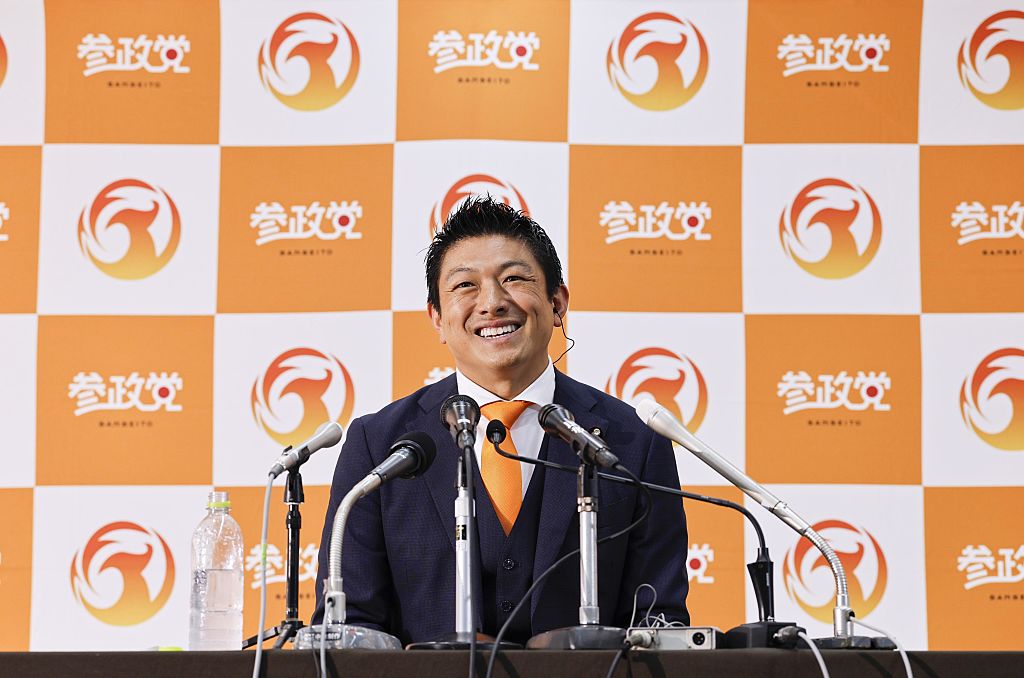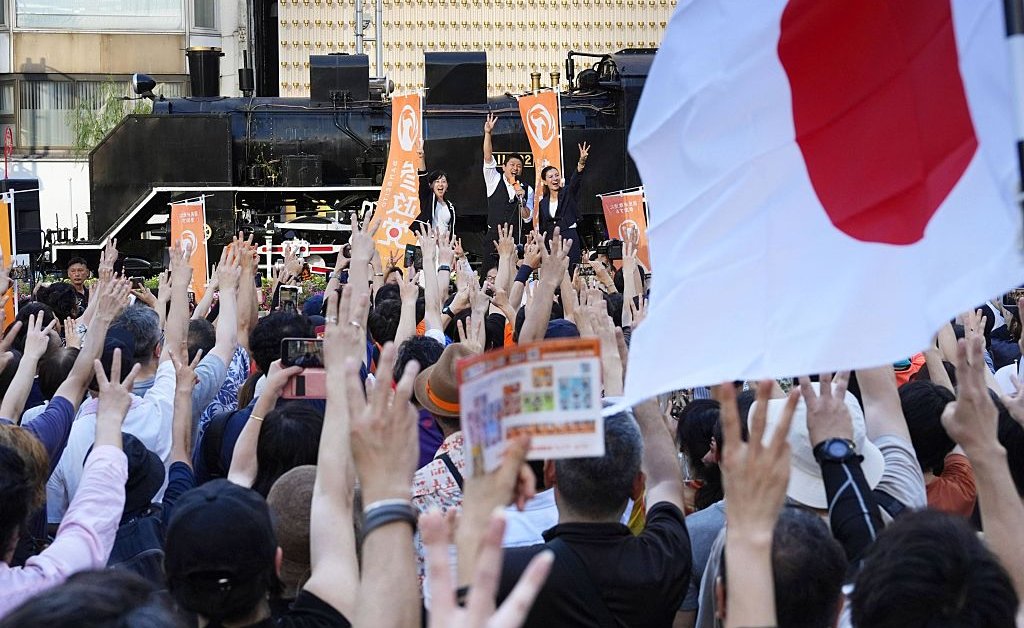Donald Trump once said he didn’t expect to win the 2016 presidential election. Less than 10 years later and months into his second term, observers say he could go down as one of the most consequential U.S. leaders in history.
Japanese politics is different in many ways, but in one, it’s having what appears to be an analogous moment: “Honestly speaking, we hadn’t expected our party would gain this much support,” said Sohei Kamiya, the Trump-like leader of the far-right Sanseito party, after July legislative elections.
Sanseito didn’t come out on top—far from it. The party won three seats in the 465-member House of Representatives and increased its number of seats from one (Kamiya’s) to 15 in the 248-member upper-chamber House of Councillors. But while Japan’s government has long been dominated by the ruling conservative Liberal Democratic Party (LDP) and main opposition, liberal Constitutional Democratic Party (CDP), Sanseito is part of a wave of smaller parties that have made inroads in recent years and appear to be gaining momentum and influence.
Whether another disruptive relative outsider could reshape a nation’s politics in less than 10 years is the question now before Japan.
Sanseito campaigned on a “Japanese first” platform, attributing growing frustrations among the Japanese populace about the economy and crime to foreigners and globalism. Kamiya has compared his party to other far-right, anti-immigrant parties around the world including the Republican Party in the U.S., Germany’s AfD, France’s National Rally, and the U.K.’s Reform Party.
“I think we can attribute a lot of this to ripples coming from the White House,” Jeff Kingston, a professor of Asian studies and history at Temple University in Tokyo, told the BBC. “Trump is empowering the primordial in people all over the world.”
Here’s what to know.
The rise of Japan’s “mini-Trump”
Like Trump, Sohei Kamiya rallies against the “deep state” and yearns to return his country to a perceived bygone era of greatness.
But unlike Trump, Kamiya, who is now 47, did not enter the political arena all of a sudden.
In his youth, Kamiya was his junior high and high school student council president, according to the Daily Shincho. In 2007, at age 29, he was elected as a city council member in Suita, Osaka prefecture. After seeing his family’s supermarket go bankrupt, he entered politics after a brief career as a schoolteacher with a goal to “change the mindset of young people in Japan,” according to his website.
In local government, Kamiya organized city officials into a cross-party conservative policy recommendation group called the Ryoma Project. The group, according to its website, seeks “the revitalization of Japan,” decrying institutional fatigue and economic decline, the loss of a spirit of independence and self-respect, and insufficient analysis of modern history. Its slogan, “changing Japan from the local level, changing the world from Japan,” implies an even more expansive goal than national rejuvenation.
During his second term on the council, Kamiya sought to take his vision to the national level and ran for the House of Representatives as an LDP member in 2012—but he lost.
Disappointed, he funneled his energy toward a YouTube channel, ChGrandStrategy, where he anchored videos “for the younger generation who will shape Japan’s future to acquire the knowledge that is not taught in school.” The channel featured lessons on history and dialogues with conservatives, and it continues to promote nationalist views and conspiracy theories to nearly 500,000 followers today.
“Kamiya sort of positions himself as a mini-Trump,” Kingston, the Asian studies professor, tells TIME. “He’s appealing to the forces of anti-globalization in Japan and appealing to youngish voters, say 30s, 40s, who are on the outside looking in, who feel that their lives haven’t worked out too well.”
 Sohei Kamiya, head of the opposition Sanseito party, speaks to reporters at the party’s election operation center in Tokyo on July 20, 2025, the day of the House of Councillors election. Kyodo News/Getty ImagesThe “do it yourself” party
Sohei Kamiya, head of the opposition Sanseito party, speaks to reporters at the party’s election operation center in Tokyo on July 20, 2025, the day of the House of Councillors election. Kyodo News/Getty ImagesThe “do it yourself” party
Having built a reputation as a right-wing YouTuber, around 2019, Kamiya and fellow political YouTuber Kazuya decided to launch a channel about the process of creating a political party.
“Based on the concept that there was no political party we wanted to vote for, we started our own YouTube channel called ‘Political Party DIY,’” Kazuya told the Daily Shincho. Joined by Yuya Watase, an international political analyst who had previously founded the Tokyo Tea Party, the trio officially founded Sanseito out of that channel in 2020. But both Kazuya and Watase quickly distanced themselves from the party as Kamiya grew its base largely on the back of promoting conspiracy theories related to the 2020 U.S. election, COVID-19, and more.
Kamiya successfully turned his fledgling party of disillusionment with the system into one that could compete with the system by capitalizing on his success as an influencer. According to Tokyo Weekender, the party raised funds by charging its most ardent followers fees for access to subscriber-only content that far exceeded other parties’ membership dues.
In 2022 legislative elections, Kamiya won a seat in the House of Councillors, a decade after his first attempt to run for parliament, and Sanseito earned 1.8 million votes, more than many long-established smaller opposition parties.
Today, the Sanseito YouTube channel has nearly 500,000 subscribers.
“Sanseito says things that other parties don’t say”
Kamiya has gained attention for his inflammatory remarks about women and his past conspiratorial writings about “Jewish international finance capital” (which he once described as being a force “behind many of the events we have learned about in history” and which “Japan has been targeted by,” though he later clarified: “I don’t have any personal prejudice against Jews”).
But his party has also gained attention for its ultraconservative agenda.
Government data shows that foreign residents in Japan have increased from 2.2 million to 3.8 million over the past decade, a slight and slow opening up prompted by a dramatic decline in birth rate, though foreigners still only account for 3% of the nation’s 120-million-strong population. Still, NHK says that the demographic shift has caused many to believe that foreigners have taken away job opportunities and real-estate from native Japanese and have posed a security threat—a perception that Sanseito has capitalized on, campaigning against a “silent invasion” of immigrants.
Even before the election, Sanseito’s anti-immigrant push appeared to influence the conservative ruling LDP, which announced a new task force to deal with foreigners, including immigrants as well as tourists, amid growing concerns about overtourism.
But immigration is not the only topic on Sanseito’s agenda.
According to a party manifesto in the Japan Times, Kamiya wrote that the party’s priorities are “education and human development, food and health, and national security.” The food and health category includes calling for a review of vaccination policies, and the national security category includes calling for the review of “radical policies related to gender and gender issues (As well as DEI (diversity, equity and inclusion) promotion policies).”
“Sanseito says things that other parties don’t say,” a supporter told the BBC. “We will raise the issues in the Diet,” Kamiya said, referring to the national parliament, after the party’s success at the polls last month.
“A hard one to predict”
Sanseito’s surge seen in the voting booths—where it reportedly won 20% of 18- and 19-year-olds’ votes—has extended after the election. A post-election Asahi Shimbun survey found that 52% of Japanese voters say it is good that the party won so many seats, and 48% support its “Japanese First” platform.
“The fact that [Sanseito] won suggests that ordinary Japanese people are very economically insecure, and they’re prioritizing their immediate economic needs over the sustainability of the state,” says Stephen Nagy, a visiting fellow at the Japan Institute for International Affairs. “I think they preyed on those insecurities.”
But despite the party’s overperformance relative to other opposition parties, it will still have limited influence in government, something most Japanese already anticipated. A Mainichi survey from June found that “nearly half of people in Japan expect little from Sanseito” by way of governance, and the newspaper suggested that Sanseito’s election success “appears to have served as an outlet for dissatisfaction with the ruling coalition.”
Kingston says that votes for Sanseito were a “protest message” against the political establishment, namely the LDP, which has had its reputation marred in years by a series of scandals and which struggled to manage concerns surrounding trade and rice in the run-up to the elections this year.
Analysts also say that Sanseito is filling an ideological void since the death of former Prime Minister Shinzo Abe. “The LDP has been unable to hold onto the revisionist and xenophobic element that used to be contained in the Abe faction,” Koichi Nakano, a visiting scholar at the Weatherhead Program on U.S.-Japan Relations at Harvard University, told the New York Times.
“For voters on the far right, they lost their home. They want a more ardent advocate for their positions. And Kamiya is that passionate advocate,” Kingston told the BBC.
Kamiya told Nikkei that his party understands that “submitting bills as political theater is meaningless” and that Sanseito has already begun to work “behind-the-scenes” with other parties to champion the policies it campaigned on. But he also made clear that his larger vision is long-term, saying that he aims to double Sanseito’s seats in parliament in the next election.
It’s going to be tough, Rintaro Nishimura, an associate at The Asia Group’s Japan Practice, told the BBC, for a party to sustain its anti-status-quo momentum if it is unable to change the status quo. “If they see that a party they supported isn’t living up to their expectations, they will revert to the established choices or move onto newer alternatives,” he said of Japanese voters.
But Kingston tells TIME that writing Sanseito off would be a mistake. “Just think of how disruptive they’ve been: I mean, a very small party—remarkable, sort of out of nowhere, from the conspiracy theories about vaccinations during COVID to 15 seats in the upper house. That was a hard one to predict.”


AloJapan.com